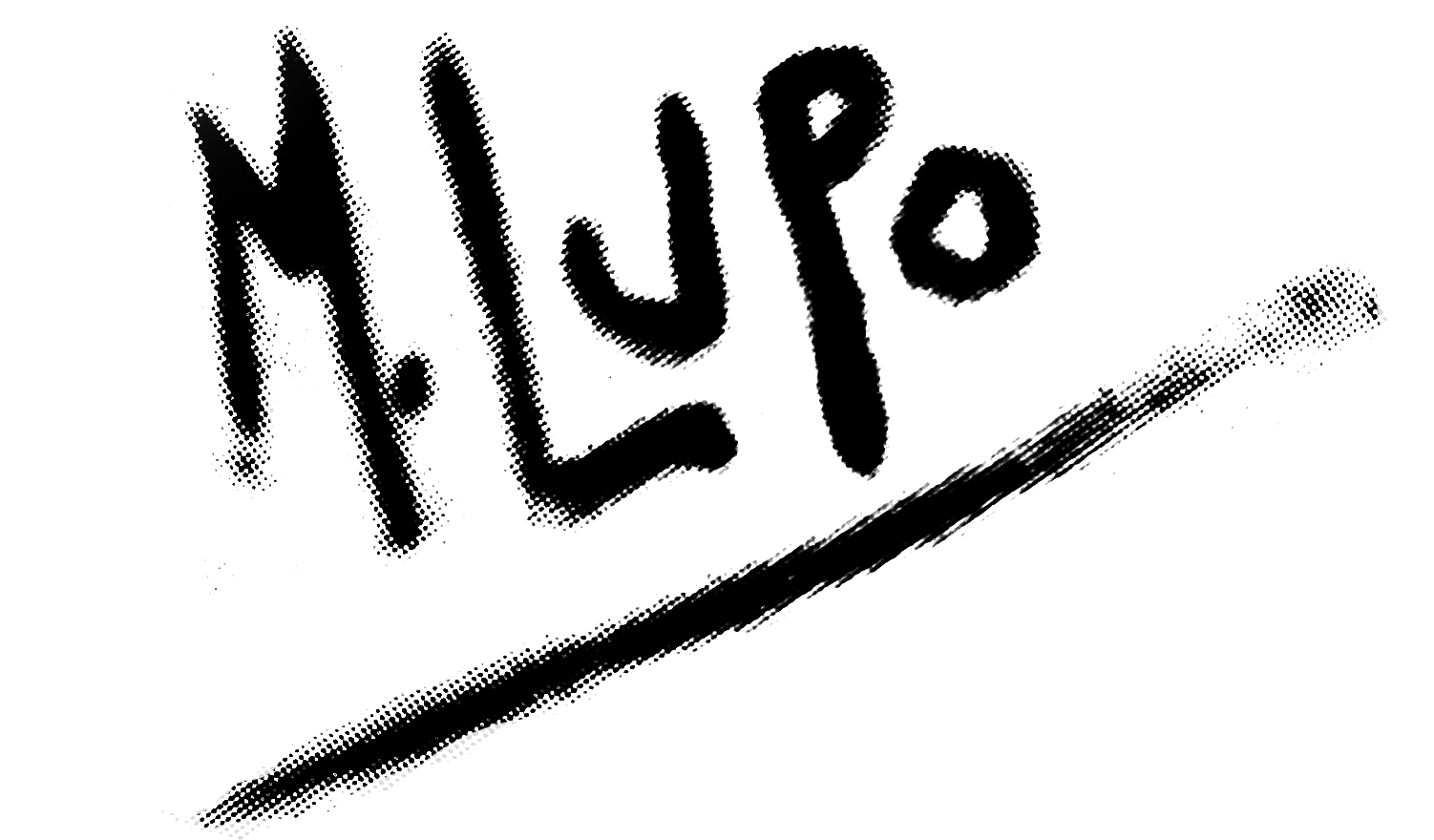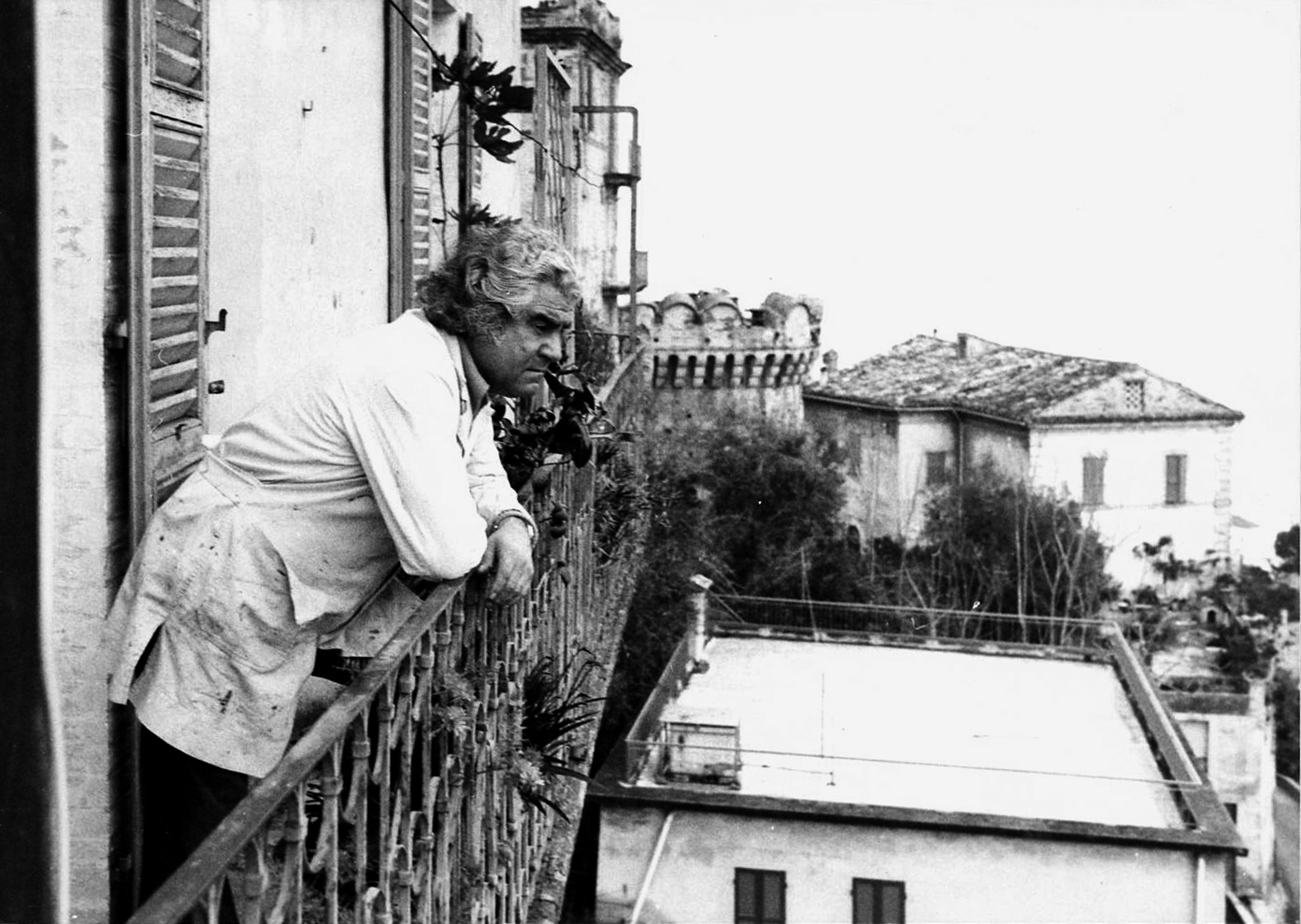
BIOGRAPHY
1926 - 1943
 Mario Lupo was born in Giulianova (TE) on 1 July 1926, to an Umbrian father - Riccardo Lupo – and an Abruzzese mother - Emilia Danese.
Mario Lupo was born in Giulianova (TE) on 1 July 1926, to an Umbrian father - Riccardo Lupo – and an Abruzzese mother - Emilia Danese.
He was born into a family of three sisters: Tilde, Giulia and Amalia. Three years later, his brother Tarcisio was born.
He spent his childhood first in Giulianova, then in Gorizia (from 1930 to 1935) and finally in Pescara, where he attended the ‘Scuola Professionale Marittima’ (Maritime Vocational School), graduating as Maritime Captain in 1943.1943 - 1953
 In August of that year, following the bombing of Pescara, he moved with his parents to Giulianova, where he met Margherita Manari, who he later married. Following his great passion for the sea, in 1945, he embarked on a small merchant ship in the port of Taranto. In 1946, he enlisted in the maritime branch of the Guardia di Finanza (Finance Police), performing his service in various locations in Liguria, Tuscany, Lazio, Sardinia, Veneto and Abruzzo. In his free time, he began to paint, copying the works of 19th-century artists. When he returned on leave to Giulianova, he painted small pictures of flowers and country houses.
In August of that year, following the bombing of Pescara, he moved with his parents to Giulianova, where he met Margherita Manari, who he later married. Following his great passion for the sea, in 1945, he embarked on a small merchant ship in the port of Taranto. In 1946, he enlisted in the maritime branch of the Guardia di Finanza (Finance Police), performing his service in various locations in Liguria, Tuscany, Lazio, Sardinia, Veneto and Abruzzo. In his free time, he began to paint, copying the works of 19th-century artists. When he returned on leave to Giulianova, he painted small pictures of flowers and country houses.1954 - 1959
1960 - 1965
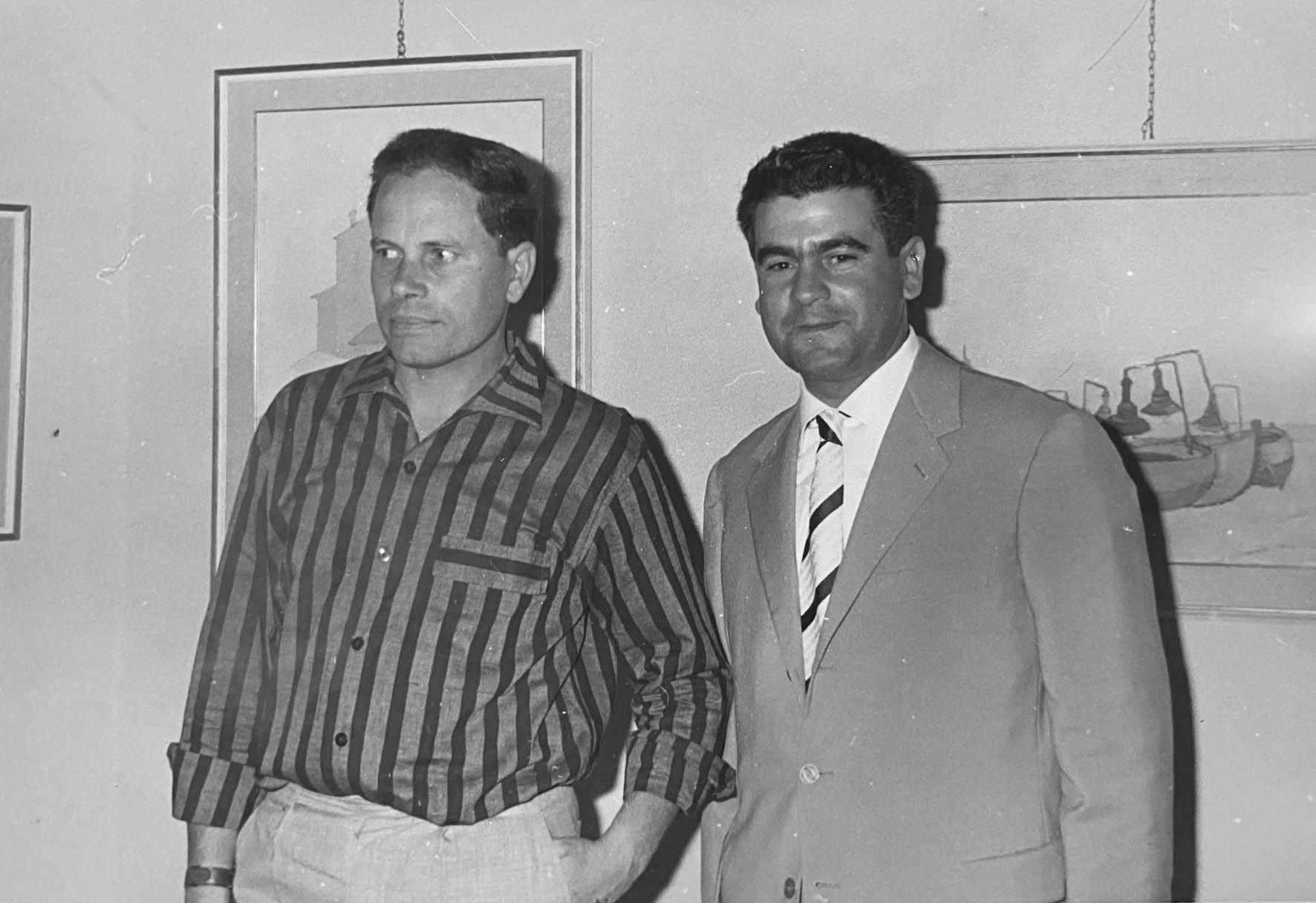 He met and spent time with painters from the Le Marche region in Ancona. In particular, his friendship with the painter Bruno Fanesi played a crucial role in the early years of his artistic training. In Ancona, he participated in numerous impromptu and collective exhibitions; he held his first solo exhibitions in Rome, Milan, Siena and San Benedetto del Tronto..
He met and spent time with painters from the Le Marche region in Ancona. In particular, his friendship with the painter Bruno Fanesi played a crucial role in the early years of his artistic training. In Ancona, he participated in numerous impromptu and collective exhibitions; he held his first solo exhibitions in Rome, Milan, Siena and San Benedetto del Tronto..
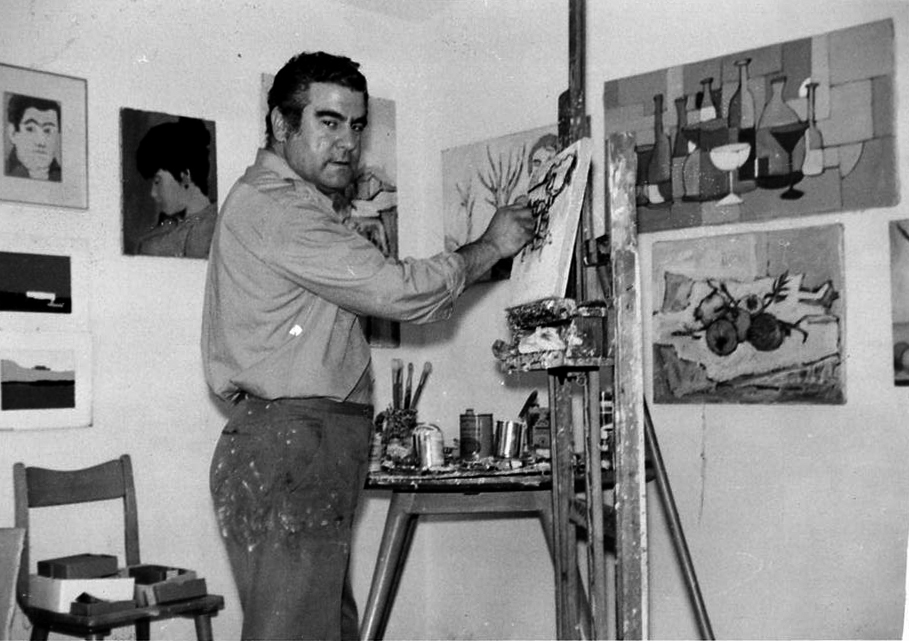 In 1963, he began to paint on Olona cotton canvas (a rough, heavy and durable fabric, mainly used in sailing) which, from then on, became his favourite surface for all his oil paintings. He acquired a greater mastery of painting technique and the use of colour, creating his own style that increasingly diverged from the canons of the primitive 'chiarista' approach. His paintings in this period depict seascapes, hilly landscapes, still life compositions, flowers, religious subjects and masks on the seashore. In 1964, he painted his first 'donna in attesa' (waiting woman), one of the main distinctive themes in his painting.
In 1963, he began to paint on Olona cotton canvas (a rough, heavy and durable fabric, mainly used in sailing) which, from then on, became his favourite surface for all his oil paintings. He acquired a greater mastery of painting technique and the use of colour, creating his own style that increasingly diverged from the canons of the primitive 'chiarista' approach. His paintings in this period depict seascapes, hilly landscapes, still life compositions, flowers, religious subjects and masks on the seashore. In 1964, he painted his first 'donna in attesa' (waiting woman), one of the main distinctive themes in his painting.1966 - 1975
 In 1966, he left the Guardia di Finanza. He moved to San Benedetto del Tronto, where he held a solo exhibition, inaugurating the 'Sala d'Arte Guglielmi', his exhibition space that was a cultural and artistic meeting place for many years, hosting numerous exhibitions of Italian and foreign painters. In 1967, he moved permanently to San Benedetto del Tronto with his family, setting up his own studio first there and then in Grottammare, in the former Teatro dell'Arancio in Piazza Peretti 1. In his 'historic' studio in Grottammare (which became a reference point for many artists, writers, collectors, critics and historians), he could finally devote all his energies to painting, which had become for him a real passion and raison d’être. This marked the beginning of an intense period of work that led him to exhibit in the main Italian cities.
In 1966, he left the Guardia di Finanza. He moved to San Benedetto del Tronto, where he held a solo exhibition, inaugurating the 'Sala d'Arte Guglielmi', his exhibition space that was a cultural and artistic meeting place for many years, hosting numerous exhibitions of Italian and foreign painters. In 1967, he moved permanently to San Benedetto del Tronto with his family, setting up his own studio first there and then in Grottammare, in the former Teatro dell'Arancio in Piazza Peretti 1. In his 'historic' studio in Grottammare (which became a reference point for many artists, writers, collectors, critics and historians), he could finally devote all his energies to painting, which had become for him a real passion and raison d’être. This marked the beginning of an intense period of work that led him to exhibit in the main Italian cities.
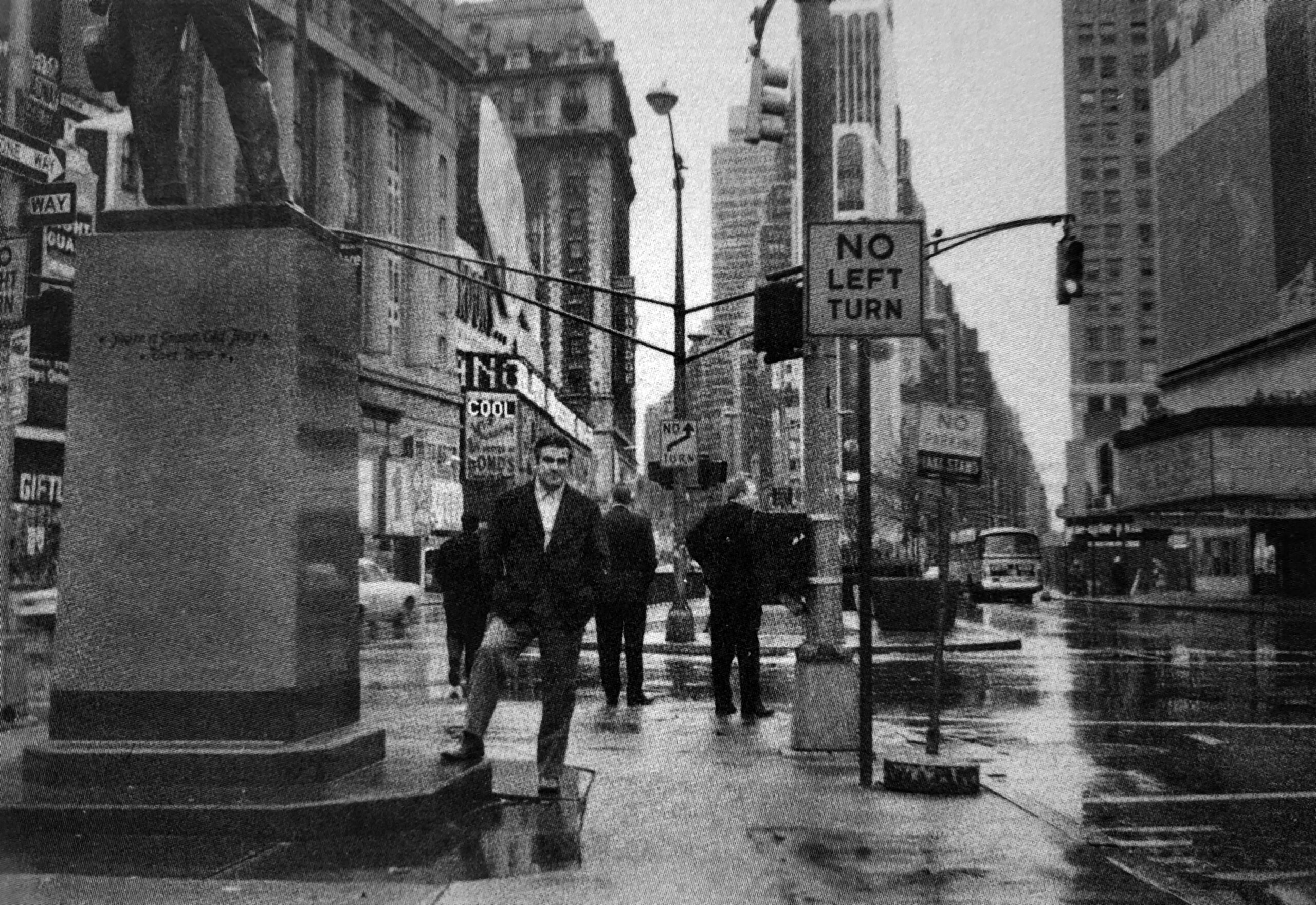 His works went on show in New York, Stockholm, Paris, St. Etienne, Geneva, Zurich, Amsterdam, Nuremberg and Toronto. Around 1969/70, the first seagulls appeared in the skies of his paintings, becoming ever-present elements and, in many cases, the main characters of his works. In 1972, at the invitation of the City of Catania, he held a solo exhibition in the Sicilian city entitled 'Omaggio a Verga’ (Homage to Verga), on the 50th anniversary of the writer's death. In 1974, at the invitation of the Provincial Tourist Board, he put on the retrospective exhibition 'Le salmastre attese’ (Brackish expectations), in the Main Hall of the Liceo Scientifico (Scientific Secondary School) of Ancona and at the Circolo Culturale San Bartolomeo (San Bartolomeo cultural club) in Bergamo. In 1975, invited by the provincial administration, he held the exhibition 'Racconti dalla Daunia’ (‘Tales from Daunia’) exhibition in Foggia.
His works went on show in New York, Stockholm, Paris, St. Etienne, Geneva, Zurich, Amsterdam, Nuremberg and Toronto. Around 1969/70, the first seagulls appeared in the skies of his paintings, becoming ever-present elements and, in many cases, the main characters of his works. In 1972, at the invitation of the City of Catania, he held a solo exhibition in the Sicilian city entitled 'Omaggio a Verga’ (Homage to Verga), on the 50th anniversary of the writer's death. In 1974, at the invitation of the Provincial Tourist Board, he put on the retrospective exhibition 'Le salmastre attese’ (Brackish expectations), in the Main Hall of the Liceo Scientifico (Scientific Secondary School) of Ancona and at the Circolo Culturale San Bartolomeo (San Bartolomeo cultural club) in Bergamo. In 1975, invited by the provincial administration, he held the exhibition 'Racconti dalla Daunia’ (‘Tales from Daunia’) exhibition in Foggia.1975 - 1979
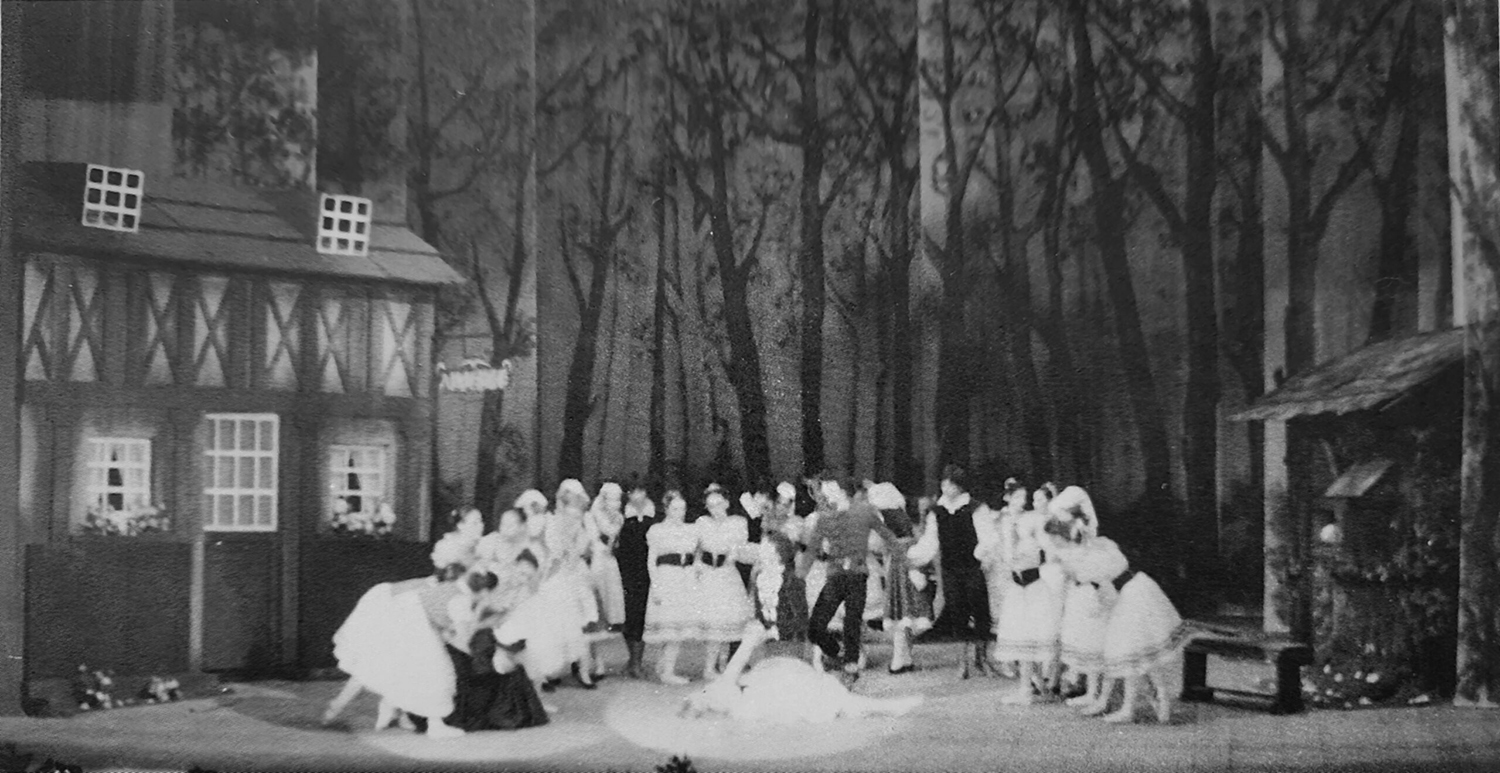 In these same years (1975/76),
In these same years (1975/76),
he met the dance teacher Caterina Ricci from Ascoli Piceno, with whom he began a fruitful partnership that continued over the following years. This led him to create his sets for the ballets 'I gabbiani' (The Seagulls), 'L'uomo e il mare' (Man and the Sea), 'Giselle' (Giselle) and 'Gli olivastri di Torre Mileto' (The Wild Olives of Torre Mileto), the premiere of which was held in 1986 at the 'Giordano' theatre in Foggia.
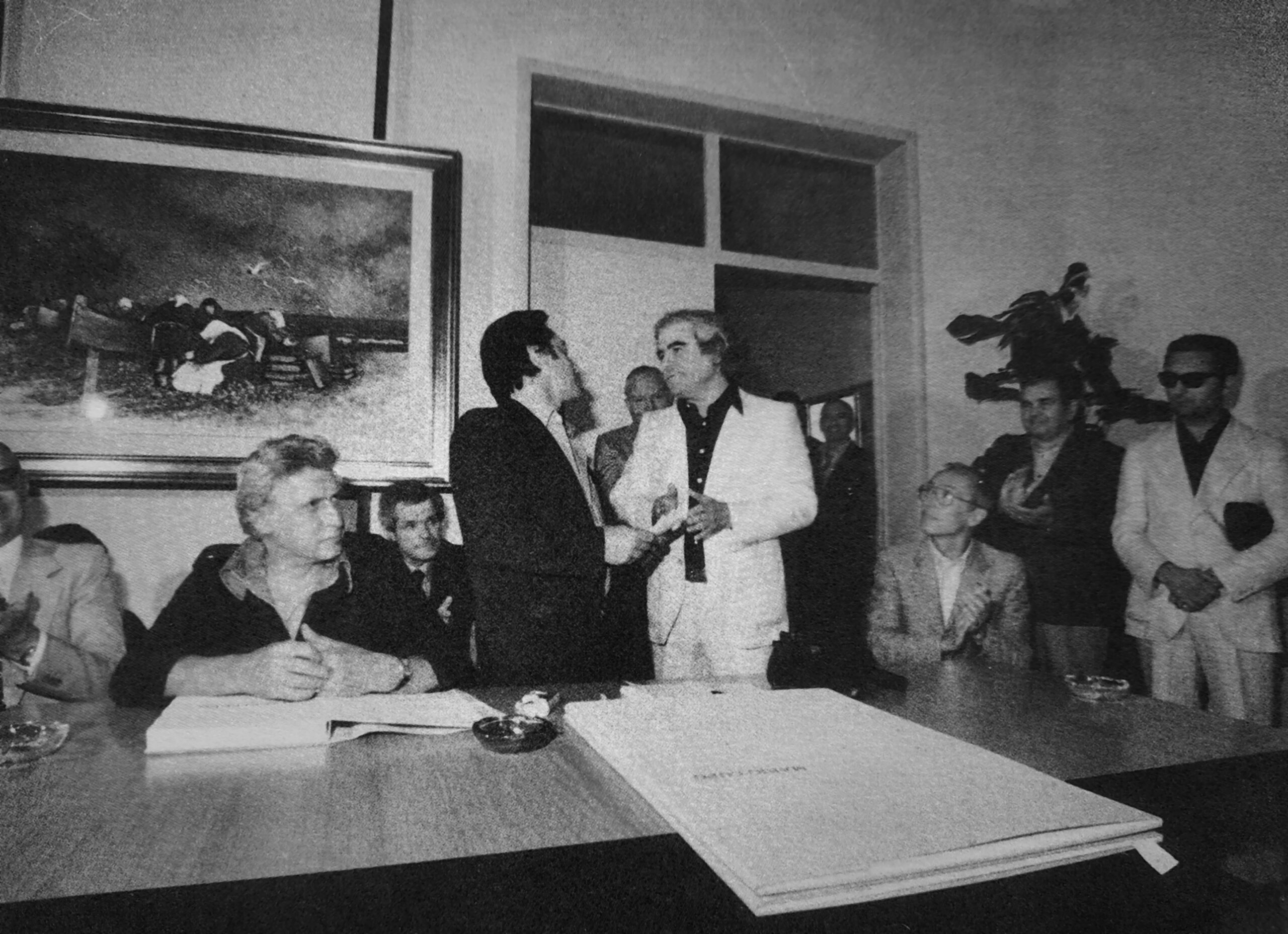 In 1977, he received the ‘Ginestra d'oro del Cònero’ prize, an annual award for painters and art writers. In the same year, he created a 60-square-metre mural entitled 'Corale attesa’ (Choral waiting) for the International Concorde factory in the industrial area of Acquaviva Picena, depicting over sixty figures (waiting women and children) against a backdrop of beach, flowers, sea and seagulls. His first anthological exhibition took place in Grottammare in the summer of 1978, with the publication of the monographic volume 'Qualche miglio di tela olona' (A few miles of olona canvas), curated by Giovanni Maria Farroni.
In 1977, he received the ‘Ginestra d'oro del Cònero’ prize, an annual award for painters and art writers. In the same year, he created a 60-square-metre mural entitled 'Corale attesa’ (Choral waiting) for the International Concorde factory in the industrial area of Acquaviva Picena, depicting over sixty figures (waiting women and children) against a backdrop of beach, flowers, sea and seagulls. His first anthological exhibition took place in Grottammare in the summer of 1978, with the publication of the monographic volume 'Qualche miglio di tela olona' (A few miles of olona canvas), curated by Giovanni Maria Farroni.
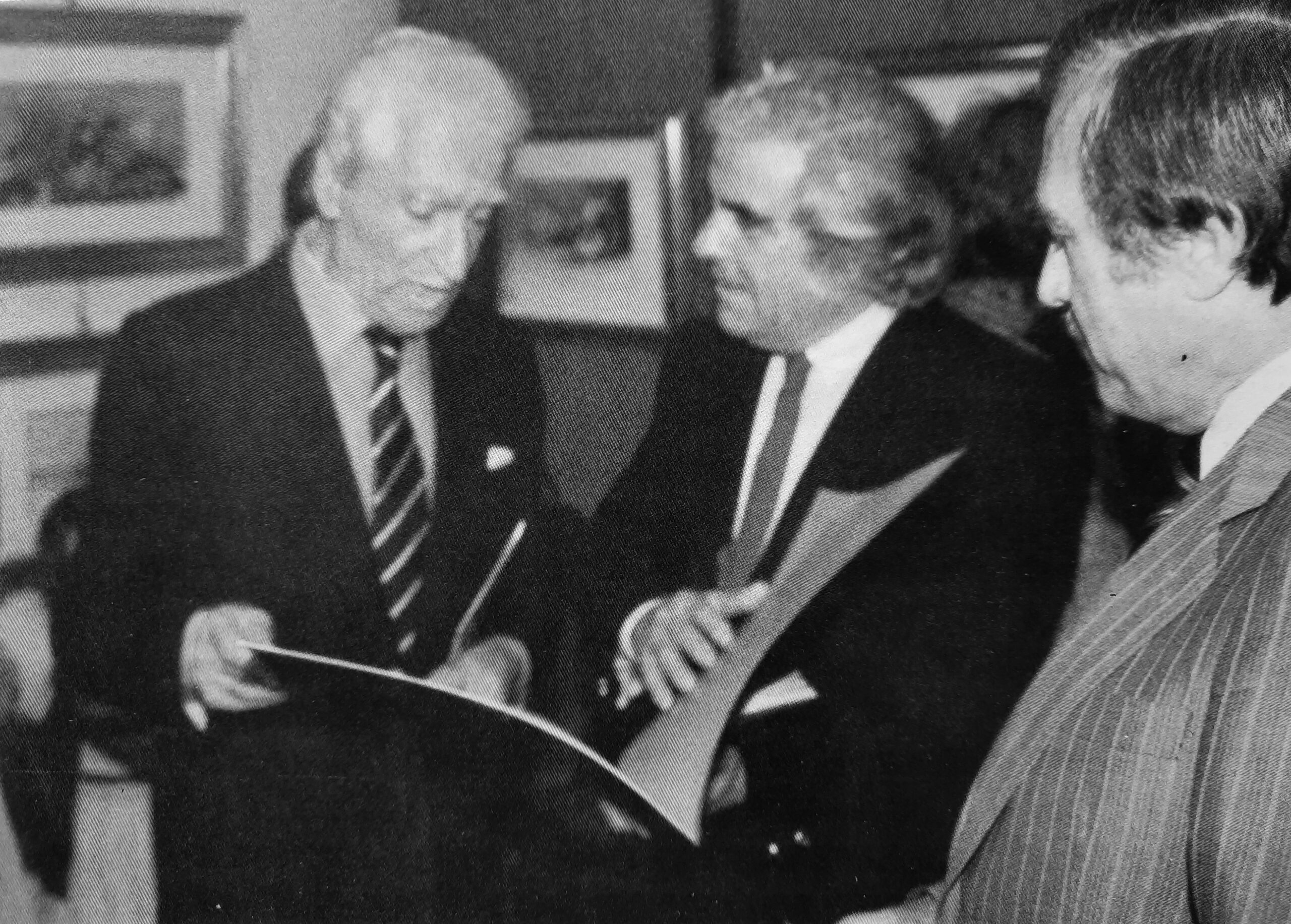 The monograph was also presented at a major exhibition at the Italian Chamber of Commerce in Paris in October of the same year and, in March 1979, at the Bonicelli brothers' Garrone gallery in Milan.
The monograph was also presented at a major exhibition at the Italian Chamber of Commerce in Paris in October of the same year and, in March 1979, at the Bonicelli brothers' Garrone gallery in Milan.1980 - 1983
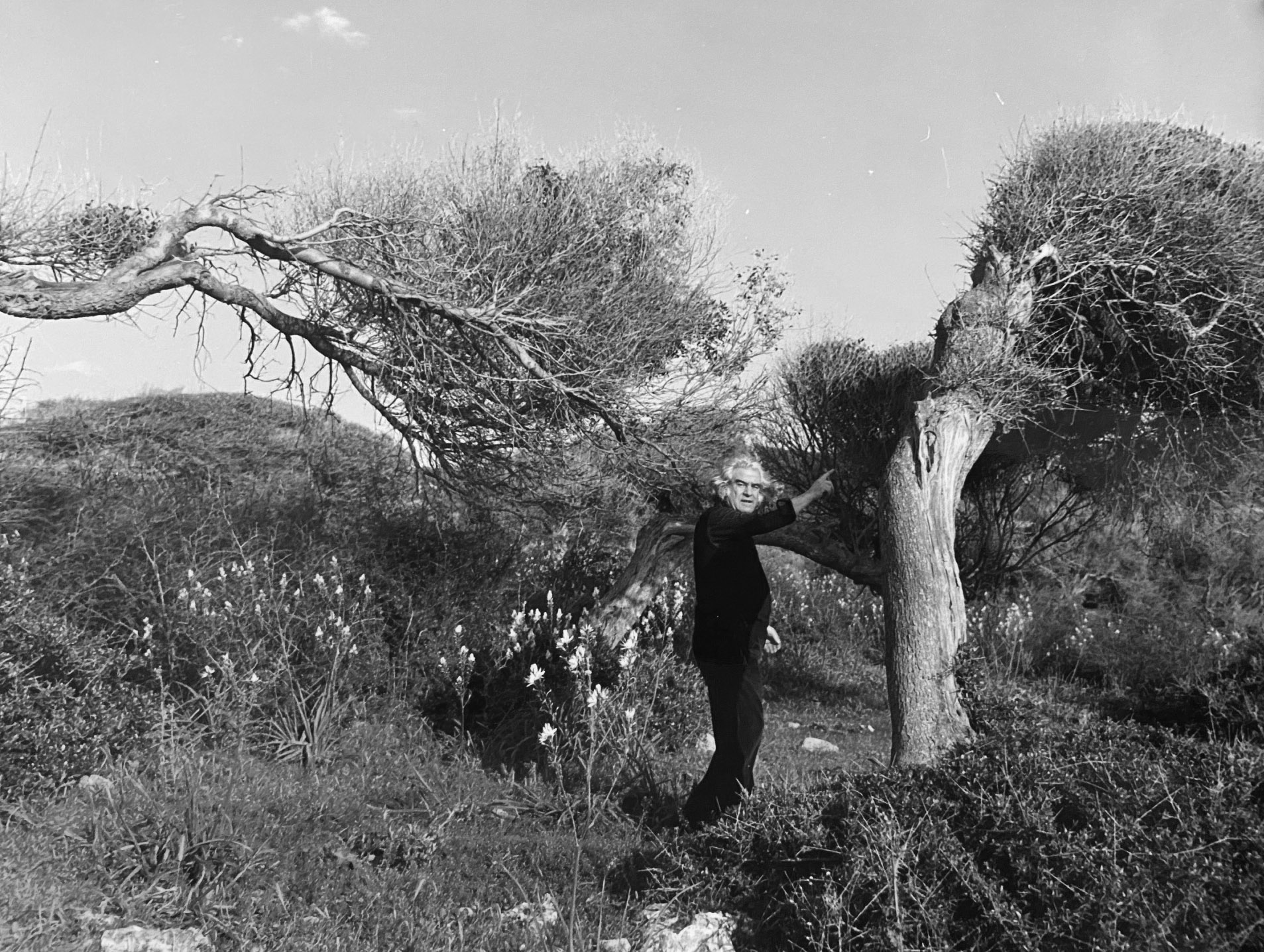 In 1980, he presented at the Musée de l'Athénée in Geneva with the 'Racconti di acqua amara’ (Tales of bitter water) exhibition.
In 1980, he presented at the Musée de l'Athénée in Geneva with the 'Racconti di acqua amara’ (Tales of bitter water) exhibition.
In 1981, in Ischitella on the Gargano, he exhibited his works inspired by the "Olivastri di Torre Mileto" (The Wild Olives of Torre Mileto). The same exhibition was then repeated in Milan, in Rome and at the 'Vicolo del Quartirolo' Gallery in Bologna.
In 1983, his anthological exhibition at the Science and Technology Museum in Milan was accompanied by the prestigious catalogue 'L'immagine corale’ (The Choral Image), with a critical essay by Franco Solmi.
 Also in 1983, he worked with the 'Fucina degli Angeli' (Forge of Angels), founded in Venice by Egidio Costantini, creating his own glass sculptures exhibited at the 'Casa Elizalde' Museum in Barcelona, at the 'Excm. Ajuntament' of Valencia, in Pordenone (within ‘Vinmondo 1983’), and at Palazzetto Eucherio San Vitale, Parco Ducale, in Parma.
Also in 1983, he worked with the 'Fucina degli Angeli' (Forge of Angels), founded in Venice by Egidio Costantini, creating his own glass sculptures exhibited at the 'Casa Elizalde' Museum in Barcelona, at the 'Excm. Ajuntament' of Valencia, in Pordenone (within ‘Vinmondo 1983’), and at Palazzetto Eucherio San Vitale, Parco Ducale, in Parma.1984 - 1987
 In December 1984, together with Pericle Fazzini, with whom he enjoyed a genuine and deep friendship, he presented a portfolio of artwork entitled 'La speranza’ (Hope), which included screenprints and etchings by the two artists, produced by Stamperia dell'Arancio, accompanied by a critical text by Dino Carlesi.
In December 1984, together with Pericle Fazzini, with whom he enjoyed a genuine and deep friendship, he presented a portfolio of artwork entitled 'La speranza’ (Hope), which included screenprints and etchings by the two artists, produced by Stamperia dell'Arancio, accompanied by a critical text by Dino Carlesi.
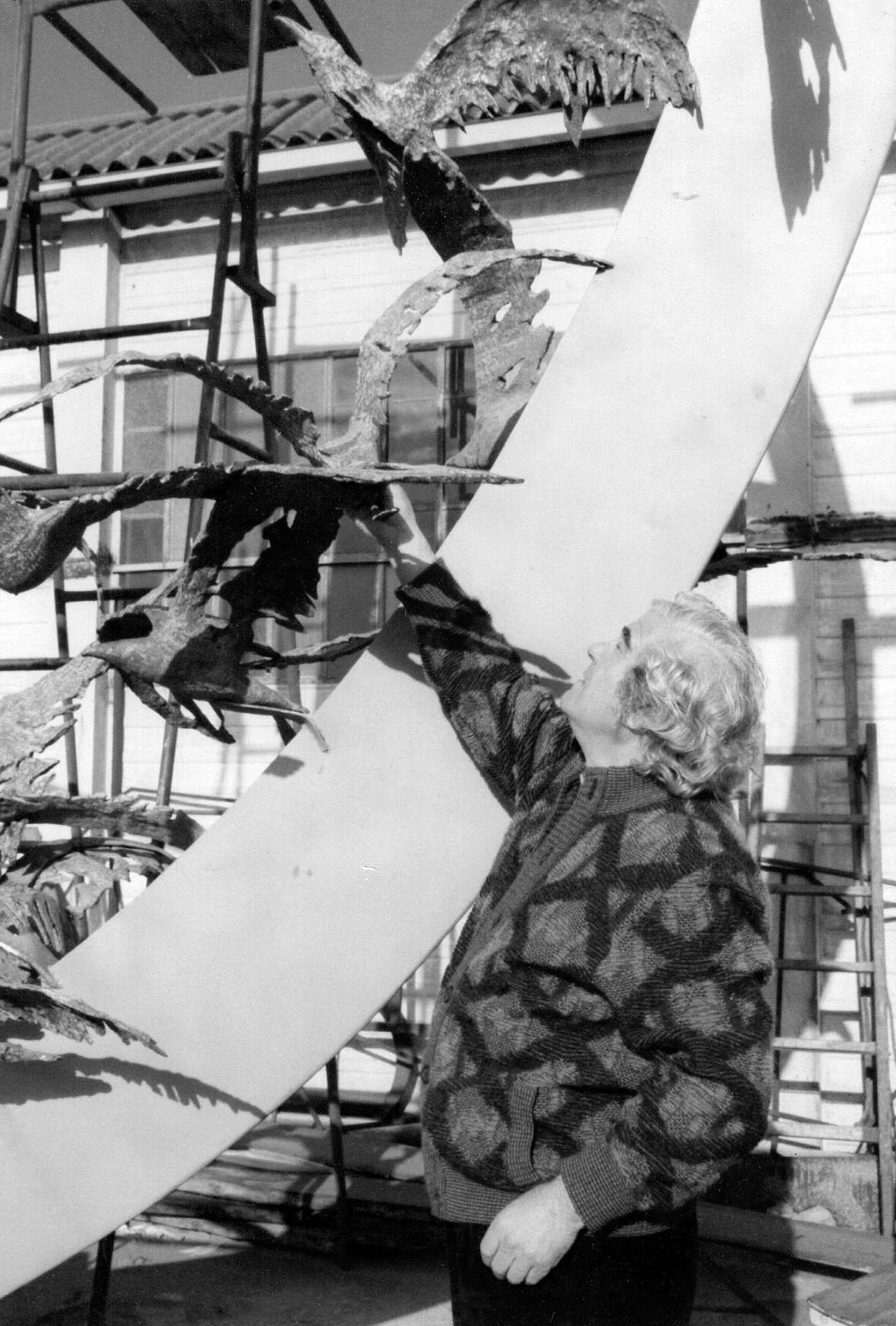 On 25 May 1986, his majestic bronze and steel monument 'Il Gabbiano Jonathan Livingston' (Jonathan Livingston Seagull) was unveiled. It was commissioned by the ‘Circolo dei Sambenedettesi’ club and erected on the south pier of San Benedetto del Tronto, of which it became the unquestionable symbol. Richard Bach, the author of the novel that inspired the monument, sent the artist a note of thanks and good wishes.
On 25 May 1986, his majestic bronze and steel monument 'Il Gabbiano Jonathan Livingston' (Jonathan Livingston Seagull) was unveiled. It was commissioned by the ‘Circolo dei Sambenedettesi’ club and erected on the south pier of San Benedetto del Tronto, of which it became the unquestionable symbol. Richard Bach, the author of the novel that inspired the monument, sent the artist a note of thanks and good wishes.
In December 1987, he held a major exhibition at the San Silvestro Cultural Centre in Osimo, under the patronage of the Town Council and the Department of Cultural Activities.1988 - 1989
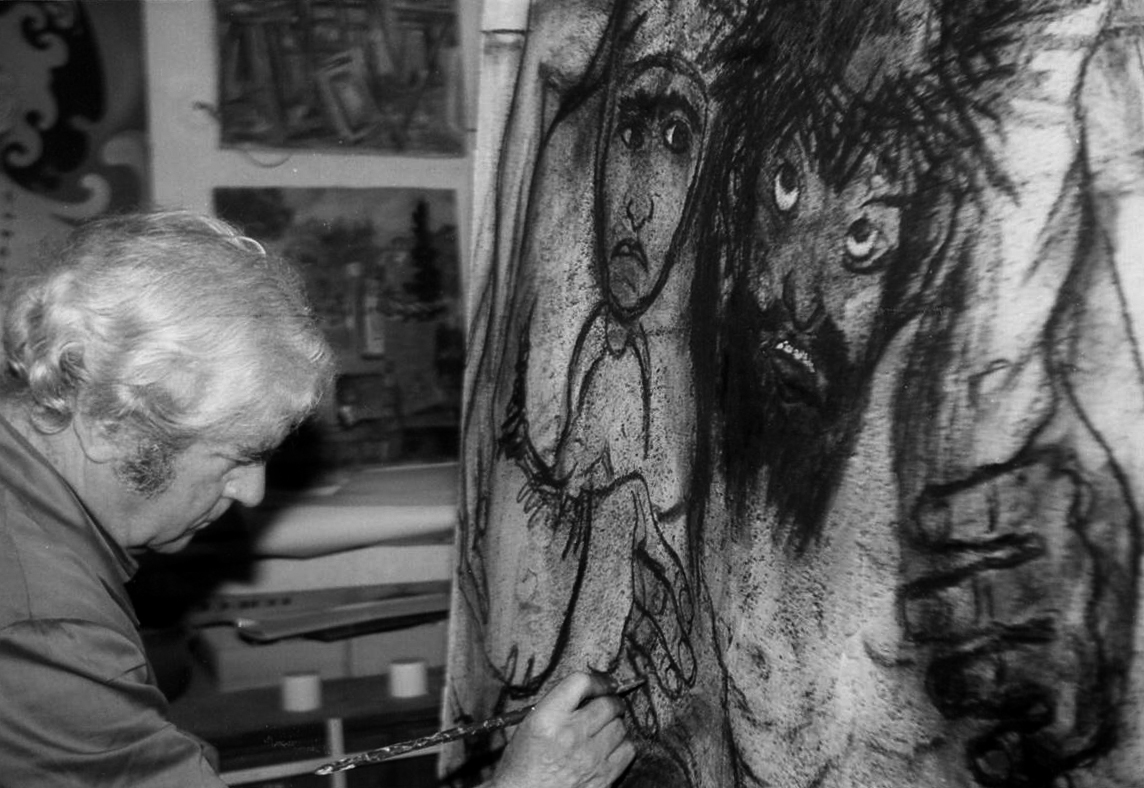 In 1988, he published the volume-catalogue 'Il Cristo di tutti' (The Christ of all), with texts by Carlo Bo, Italo Mancini, Valerio Volpini and eleven poems by Father David Maria Turoldo, presenting the exhibition of the same name, inspired by the mystery of the Cross, at Centro San Fedele in Milan. The works were then exhibited in Urbino during the events held in memory of Paul VI (August 1988), in Osimo, at Palazzo Campana (Holy Week 1989), and in Mombaroccio, at the sanctuary of Beato Sante (September 1990).
In 1988, he published the volume-catalogue 'Il Cristo di tutti' (The Christ of all), with texts by Carlo Bo, Italo Mancini, Valerio Volpini and eleven poems by Father David Maria Turoldo, presenting the exhibition of the same name, inspired by the mystery of the Cross, at Centro San Fedele in Milan. The works were then exhibited in Urbino during the events held in memory of Paul VI (August 1988), in Osimo, at Palazzo Campana (Holy Week 1989), and in Mombaroccio, at the sanctuary of Beato Sante (September 1990).
 Also in 1988, for the 'Cabaret amore mio!’ (Cabaret my love!) festival in Grottammare, he created the 'Arancia d'oro' (golden orange) prize (a sculpture in gold and precious stones), which was awarded annually to a top comedian. In December 1989, he held a retrospective exhibition at Marche Polytechnic University in Ancona, with a catalogue text by Floriano De Santi. As part of the exhibition, his autobiography 'Racconto la vita racconto la pittura (Telling a story about life and painting) was presented. This book gives a delightful, thorough and complete account of his childhood, friends, family, travels, and the discovery of painting and exhibitions, all richly accompanied by photographic material in which many private images appear in addition to his works of art.
Also in 1988, for the 'Cabaret amore mio!’ (Cabaret my love!) festival in Grottammare, he created the 'Arancia d'oro' (golden orange) prize (a sculpture in gold and precious stones), which was awarded annually to a top comedian. In December 1989, he held a retrospective exhibition at Marche Polytechnic University in Ancona, with a catalogue text by Floriano De Santi. As part of the exhibition, his autobiography 'Racconto la vita racconto la pittura (Telling a story about life and painting) was presented. This book gives a delightful, thorough and complete account of his childhood, friends, family, travels, and the discovery of painting and exhibitions, all richly accompanied by photographic material in which many private images appear in addition to his works of art.1990 - 1991
In the spring of 1990, he exhibited at the gallery ‘St. Nikolaus’ in Stockholm and at Helvetia Assurances in Geneva. In October of that year, he was invited to Stresa for ‘The model for art’ event. In 1991, in Tortoreto Lido (TE), he created an imposing bronze sculpture in honour of Carabinieri General Enrico R. Galvaligi, General Carlo Alberto Dalla Chiesa's right-hand man, who was assassinated by the Red Brigades during the years of political terror.
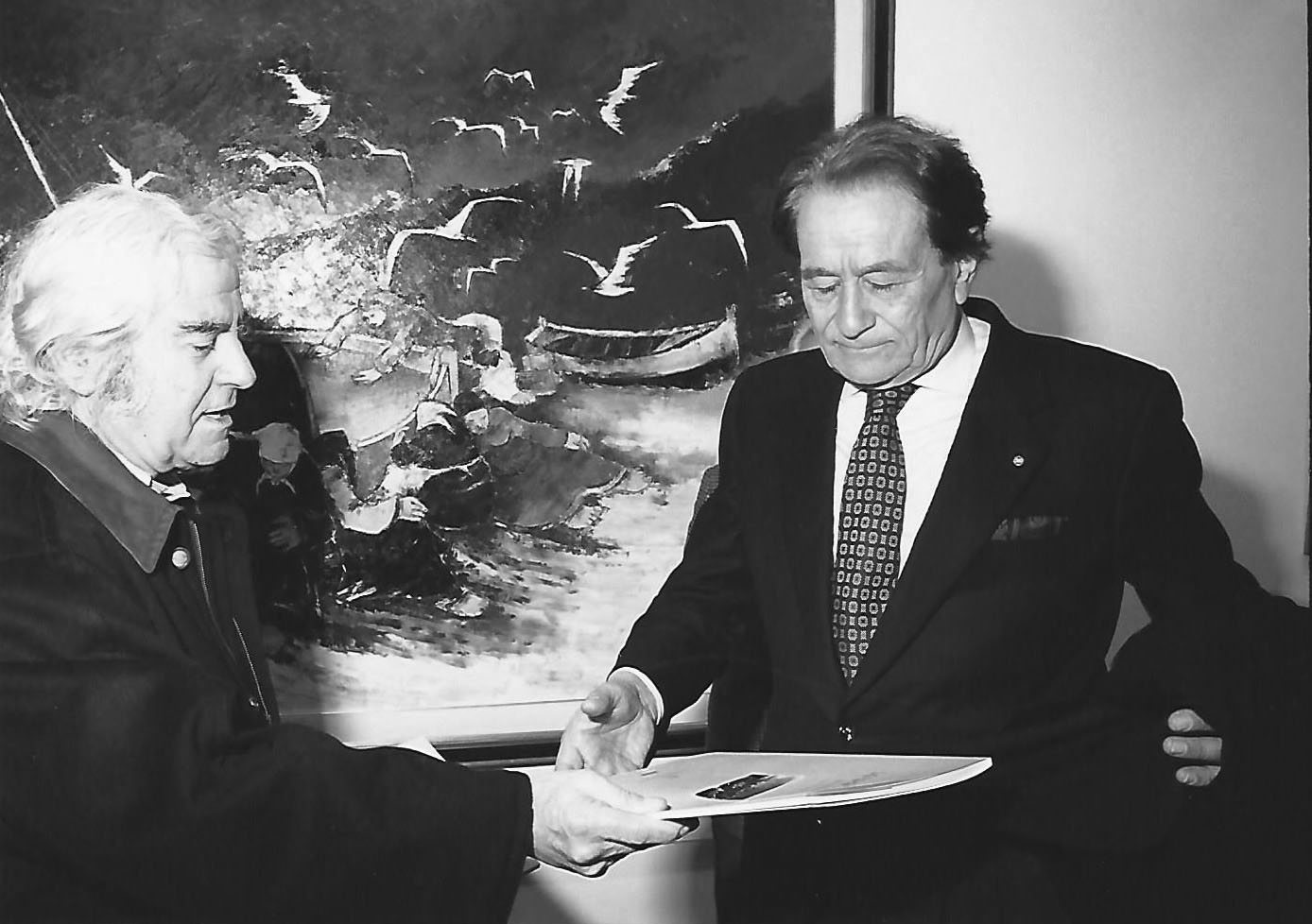 In December 1991, he opened his exhibition ‘Burrasche’ (Storms) show in Grottammare, in the exhibition space annexed to Stamperia dell'Arancio owned by his son Riccardo, a publisher and gallery owner of profound culture and great expertise.
In December 1991, he opened his exhibition ‘Burrasche’ (Storms) show in Grottammare, in the exhibition space annexed to Stamperia dell'Arancio owned by his son Riccardo, a publisher and gallery owner of profound culture and great expertise.1992
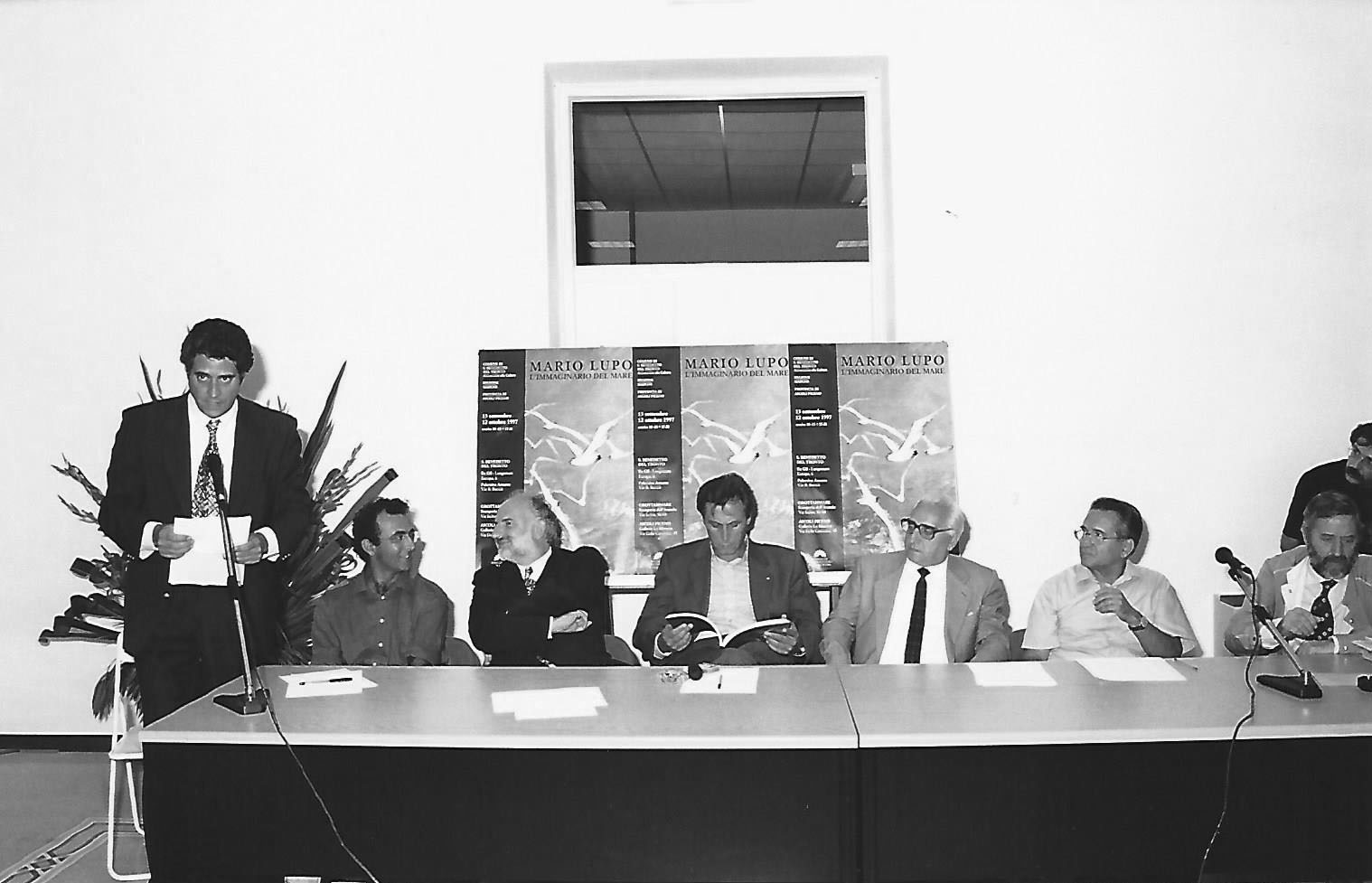 Two retrospectives were dedicated to Mario Lupo in 1996, thanks to the enthusiastic commitment of his son Riccardo, assisted by his sister Maristella. They were held respectively at Palazzetto dell'Arte in Foggia and at the Kursaal in Giulianova. Then, in 1997, a sizeable retrospective was held in San Benedetto del Tronto, in the premises of the Ex Gil and at the Palazzina Azzurra, with the publication of the catalogue 'L'immaginario del mare’ (The Imaginary of the Sea) by Stamperia dell'Arancio.
Two retrospectives were dedicated to Mario Lupo in 1996, thanks to the enthusiastic commitment of his son Riccardo, assisted by his sister Maristella. They were held respectively at Palazzetto dell'Arte in Foggia and at the Kursaal in Giulianova. Then, in 1997, a sizeable retrospective was held in San Benedetto del Tronto, in the premises of the Ex Gil and at the Palazzina Azzurra, with the publication of the catalogue 'L'immaginario del mare’ (The Imaginary of the Sea) by Stamperia dell'Arancio.

BIOGRAPHY
1926 - 1943

Mario Lupo was born in Giulianova (TE) on 1 July 1926, to an Umbrian father - Riccardo Lupo – and an Abruzzese mother - Emilia Danese.
He was born into a family of three sisters: Tilde, Giulia and Amalia. Three years later, his brother Tarcisio was born.
He spent his childhood first in Giulianova, then in Gorizia (from 1930 to 1935) and finally in Pescara, where he attended the ‘Scuola Professionale Marittima’ (Maritime Vocational School), graduating as Maritime Captain in 1943.1943 - 1953

In August of that year, following the bombing of Pescara, he moved with his parents to Giulianova, where he met Margherita Manari, who he later married. Following his great passion for the sea, in 1945, he embarked on a small merchant ship in the port of Taranto. In 1946, he enlisted in the maritime branch of the Guardia di Finanza (Finance Police), performing his service in various locations in Liguria, Tuscany, Lazio, Sardinia, Veneto and Abruzzo. In his free time, he began to paint, copying the works of 19th-century artists. When he returned on leave to Giulianova, he painted small pictures of flowers and country houses.1954 - 1959
1960 - 1965

He met and spent time with painters from the Le Marche region in Ancona. In particular, his friendship with the painter Bruno Fanesi played a crucial role in the early years of his artistic training. In Ancona, he participated in numerous impromptu and collective exhibitions; he held his first solo exhibitions in Rome, Milan, Siena and San Benedetto del Tronto.

In 1963, he began to paint on Olona cotton canvas (a rough, heavy and durable fabric, mainly used in sailing) which, from then on, became his favourite surface for all his oil paintings. He acquired a greater mastery of painting technique and the use of colour, creating his own style that increasingly diverged from the canons of the primitive 'chiarista' approach. His paintings in this period depict seascapes, hilly landscapes, still life compositions, flowers, religious subjects and masks on the seashore. In 1964, he painted his first 'donna in attesa' (waiting woman), one of the main distinctive themes in his painting.1966 - 1975

In 1966, he left the Guardia di Finanza. He moved to San Benedetto del Tronto, where he held a solo exhibition, inaugurating the 'Sala d'Arte Guglielmi', his exhibition space that was a cultural and artistic meeting place for many years, hosting numerous exhibitions of Italian and foreign painters. In 1967, he moved permanently to San Benedetto del Tronto with his family, setting up his own studio first there and then in Grottammare, in the former Teatro dell'Arancio in Piazza Peretti 1. In his 'historic' studio in Grottammare (which became a reference point for many artists, writers, collectors, critics and historians), he could finally devote all his energies to painting, which had become for him a real passion and raison d’être. This marked the beginning of an intense period of work that led him to exhibit in the main Italian cities..

His works went on show in New York, Stockholm, Paris, St. Etienne, Geneva, Zurich, Amsterdam, Nuremberg and Toronto. Around 1969/70, the first seagulls appeared in the skies of his paintings, becoming ever-present elements and, in many cases, the main characters of his works. In 1972, at the invitation of the City of Catania, he held a solo exhibition in the Sicilian city entitled 'Omaggio a Verga’ (Homage to Verga), on the 50th anniversary of the writer's death. In 1974, at the invitation of the Provincial Tourist Board, he put on the retrospective exhibition 'Le salmastre attese’ (Brackish expectations), in the Main Hall of the Liceo Scientifico (Scientific Secondary School) of Ancona and at the Circolo Culturale San Bartolomeo (San Bartolomeo cultural club) in Bergamo. In 1975, invited by the provincial administration, he held the exhibition 'Racconti dalla Daunia’ (‘Tales from Daunia’) exhibition in Foggia.1975 - 1979

In these same years (1975/76),
he met the dance teacher Caterina Ricci from Ascoli Piceno, with whom he began a fruitful partnership that continued over the following years. This led him to create his sets for the ballets 'I gabbiani' (The Seagulls), 'L'uomo e il mare' (Man and the Sea), 'Giselle' (Giselle) and 'Gli olivastri di Torre Mileto' (The Wild Olives of Torre Mileto), the premiere of which was held in 1986 at the 'Giordano' theatre in Foggia.

In 1977, he received the ‘Ginestra d'oro del Cònero’ prize, an annual award for painters and art writers. In the same year, he created a 60-square-metre mural entitled 'Corale attesa’ (Choral waiting) for the International Concorde factory in the industrial area of Acquaviva Picena, depicting over sixty figures (waiting women and children) against a backdrop of beach, flowers, sea and seagulls. His first anthological exhibition took place in Grottammare in the summer of 1978, with the publication of the monographic volume 'Qualche miglio di tela olona' (A few miles of olona canvas), curated by Giovanni Maria Farroni.

The monograph was also presented at a major exhibition at the Italian Chamber of Commerce in Paris in October of the same year and, in March 1979, at the Bonicelli brothers' Garrone gallery in Milan.1980 - 1983

In 1980, he presented at the Musée de l'Athénée in Geneva with the 'Racconti di acqua amara’ (Tales of bitter water) exhibition.
In 1981, in Ischitella on the Gargano, he exhibited his works inspired by the "Olivastri di Torre Mileto" (The Wild Olives of Torre Mileto). The same exhibition was then repeated in Milan, in Rome and at the 'Vicolo del Quartirolo' Gallery in Bologna.
In 1983, his anthological exhibition at the Science and Technology Museum in Milan was accompanied by the prestigious catalogue 'L'immagine corale’ (The Choral Image), with a critical essay by Franco Solmi.

Also in 1983, he worked with the 'Fucina degli Angeli' (Forge of Angels), founded in Venice by Egidio Costantini, creating his own glass sculptures exhibited at the 'Casa Elizalde' Museum in Barcelona, at the 'Excm. Ajuntament' of Valencia, in Pordenone (within ‘Vinmondo 1983’), and at Palazzetto Eucherio San Vitale, Parco Ducale, in Parma.1984 - 1987

In December 1984, together with Pericle Fazzini, with whom he enjoyed a genuine and deep friendship, he presented a portfolio of artwork entitled 'La speranza’ (Hope), which included screenprints and etchings by the two artists, produced by Stamperia dell'Arancio, accompanied by a critical text by Dino Carlesi.

On 25 May 1986, his majestic bronze and steel monument 'Il Gabbiano Jonathan Livingston' (Jonathan Livingston Seagull) was unveiled. It was commissioned by the ‘Circolo dei Sambenedettesi’ club and erected on the south pier of San Benedetto del Tronto, of which it became the unquestionable symbol. Richard Bach, the author of the novel that inspired the monument, sent the artist a note of thanks and good wishes.
In December 1987, he held a major exhibition at the San Silvestro Cultural Centre in Osimo, under the patronage of the Town Council and the Department of Cultural Activities.1988 - 1989

In 1988, he published the volume-catalogue 'Il Cristo di tutti' (The Christ of all), with texts by Carlo Bo, Italo Mancini, Valerio Volpini and eleven poems by Father David Maria Turoldo, presenting the exhibition of the same name, inspired by the mystery of the Cross, at Centro San Fedele in Milan. The works were then exhibited in Urbino during the events held in memory of Paul VI (August 1988), in Osimo, at Palazzo Campana (Holy Week 1989), and in Mombaroccio, at the sanctuary of Beato Sante (September 1990).

Also in 1988, for the 'Cabaret amore mio!’ (Cabaret my love!) festival in Grottammare, he created the 'Arancia d'oro' (golden orange) prize (a sculpture in gold and precious stones), which was awarded annually to a top comedian. In December 1989, he held a retrospective exhibition at Marche Polytechnic University in Ancona, with a catalogue text by Floriano De Santi. As part of the exhibition, his autobiography 'Racconto la vita racconto la pittura (Telling a story about life and painting) was presented. This book gives a delightful, thorough and complete account of his childhood, friends, family, travels, and the discovery of painting and exhibitions, all richly accompanied by photographic material in which many private images appear in addition to his works of art.1990 - 1991
In the spring of 1990, he exhibited at the gallery ‘St. Nikolaus’ in Stockholm and at Helvetia Assurances in Geneva. In October of that year, he was invited to Stresa for ‘The model for art’ event. In 1991, in Tortoreto Lido (TE), he created an imposing bronze sculpture in honour of Carabinieri General Enrico R. Galvaligi, General Carlo Alberto Dalla Chiesa's right-hand man, who was assassinated by the Red Brigades during the years of political terror.

In December 1991, he opened his exhibition ‘Burrasche’ (Storms) show in Grottammare, in the exhibition space annexed to Stamperia dell'Arancio owned by his son Riccardo, a publisher and gallery owner of profound culture and great expertise.1992
Two retrospectives were dedicated to Mario Lupo in 1996, thanks to the enthusiastic commitment of his son Riccardo, assisted by his sister Maristella. They were held respectively at Palazzetto dell'Arte in Foggia and at the Kursaal in Giulianova. Then, in 1997, a sizeable retrospective was held in San Benedetto del Tronto, in the premises of the Ex Gil and at the Palazzina Azzurra, with the publication of the catalogue 'L'immaginario del mare’ (The Imaginary of the Sea) by Stamperia dell'Arancio.
